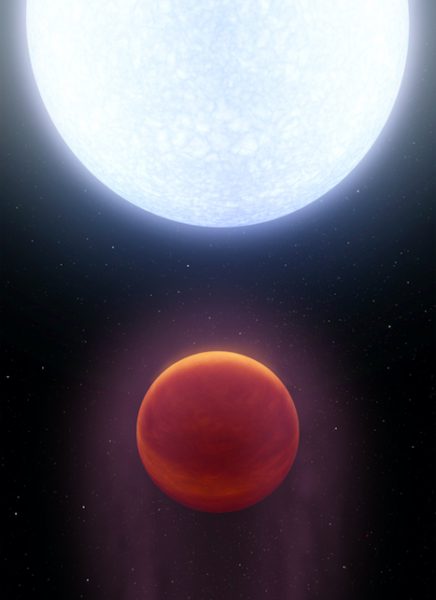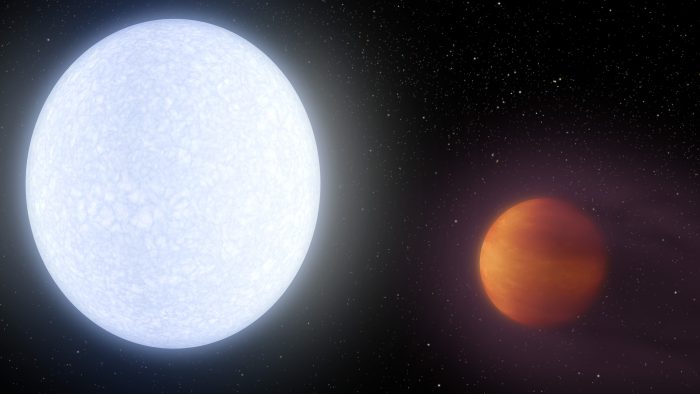Summer is almost here in North America. That means that hotter days are ahead. Some of those days might drive a few of us to say something like, "It's too hot today!"
And while it might feel really hot at the time, we can all be thankful that we don't live somewhere else. Like say, on KELT-9b?
Hotter than a star
KELT-9b is a planet that was recently discovered by operators of the Kilodegree Extremely Little Telescope (or KELT, for short) in Arizona. Hence its name! KELT-9b is a huge gas giant that orbits a huge star, KELT-9, which is about twice as large and hot as the Sun. And KELT-9b orbits it closely.
Very closely.
KELT-9b completes an orbit around its star once every 1.5 Earth days. So about once every 36 hours. (By comparison, our nearest planet, Mercury, has an orbit of 88 days.) All of which means that this video is sped up... but not really by all that much!
An artist's interpretation of what the planet and its star might look like in orbit. (NASA/JPL-Caltech)
An atmosphere-pounding heat
As you might guess, being that close to a massive star comes with some consequences. The first of which is unbelievable heat. KELT-9b is not just the hottest planet ever found—it is even hotter than most stars.
Its surface is estimated to be 4,300°C (7,800°F), which is only 1,200°C (2,200°F) cooler than the surface of the Sun. (Of course, the real hot spot on the Sun is its corona or atmosphere—its wild temperature can reach, even exceed, 3 million°C or 5.4 million°F!) So this KELT-9b is a real scorcher, and definitely not a potential home to life.
It is also tidally-locked to its star. This means that its orbit is so close that it doesn't rotate on its axis and the same side of it always faces the star. (The Moon, for example, is tidally-locked to Earth.) So its day side is the part of the planet that experiences most of this monstrous heat.
All puffed up

"Ouchy! Too close! Too hot!" (NASA/JPL-Caltech)
And there's still more neat stuff about KELT-9b, the hottest planet around!
- Astronomers believe that this intense heat and radiation has "puffed up" the planet's atmosphere. This means that while it is 2.8 times the size of Jupiter, it is only half as dense.
- Molecules such as carbon dioxide and water cannot exist in its brutal atmosphere.
- Though scientists need to use the Hubble telescope to look closer, they guess that KELP-9b will have a "tail" of particles being blasted off of it, much like a comet. (This is shown in the video above.)
- And because of this, they theorize that eventually the entire planet could be blasted into nothing but a small rocky core (making it look like Mercury). Or into something even less than that! That's the kind of intense heat and radiation that KELT-9 is firing at this planet every second.
Wow. Now that is hot. We promise to never complain about summer again!
 Meet KELT-9, and its planet, KELT-9b: the hottest planet known. (NASA/JPL-Caltech)
Meet KELT-9, and its planet, KELT-9b: the hottest planet known. (NASA/JPL-Caltech)










that is amazing 😀 😀 😀
😎 😯
that is super coooooooooooooooooooollllllllllllllllllllllllllllll!!!!!!!!!!!!!!!! ❗ ❗ 🙂 🙂 oh my